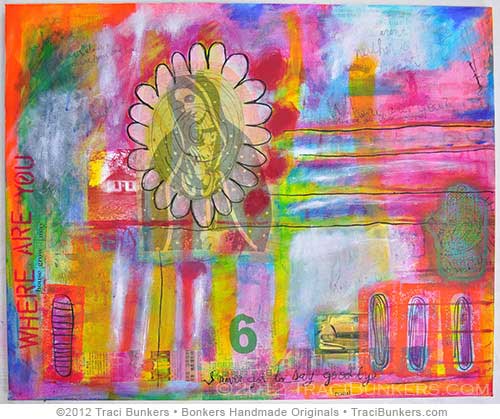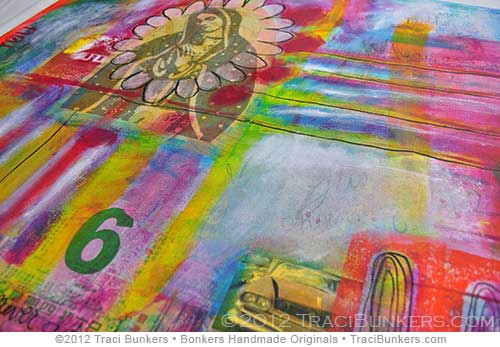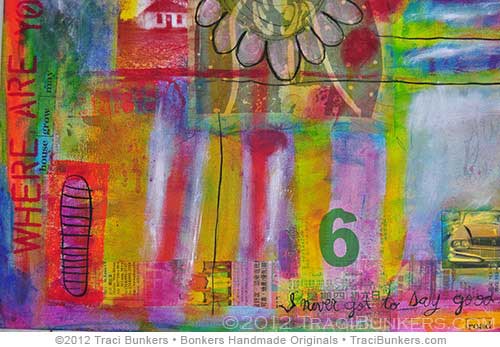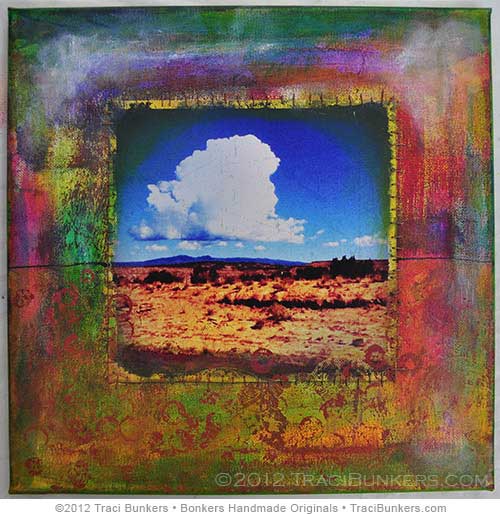This is something that is never a problem when I’m working in my journal. I just know when I’m done. I feel it. (And for me, often it’s when there’s no room to do anything else . . .) But with artwork, it’s not the same. I often question whether something is done, or if I’m saying it is, because I don’t know what to do next.
I know in the art journaling workshops I teach, that’s also the case with my students–they think they are done with a journal spread or exercise, simply because they don’t know what the next step is, or are afraid to push themselves. Because this isn’t an issue for me with my art journaling, I hope that when I feel more secure with my mixed-media paintings, and where I’m going with them, it’ll be easier to know when I’m done, and when to keep pushing.

Since I’m trying to get back on track with life, and self-care, I’m doing artwork again first thing in the morning. I had hoped to start yesterday, but had to finish a deadline, and also had to wait for the FedEx guy so I could sign for a package. (I’d miss him if I were working in my studio.)

So, today was the first day back at the easel, so to speak. I was excited to get back to art making/meaning-making. I had a lot of pieces in progress that I hadn’t worked on in quite awhile. I thought about getting out a new canvas, and gluing shit down and slapping paint on. But I knew in doing that, I’d be avoiding my pieces I hadn’t finished yet. And that would mean I’d be adding to the unfinished work, and not making progress on having new pieces for an upcoming show I have that opens next week.

I made myself work on this large piece that I started mid-June, when I returned from the Estes Park Wool Market. I loved working on the piece, but then Goliath disappeared, and the piece really became about him. I think that’s part of why I was avoiding it. It made me sad.
But, it was also in that limbo-state of whether or not it was finished. I knew it wasn’t. Today I worked on it a little more, and I’m back to wondering if it’s done. It’s definitely closer. I gave it more visual focus. But I need to think more on it. Or just work more on it and set the brain aside. My work is better when I can get out of my head.

Here’s another piece in limbo. But I think this “might” be done. I did the stitching on it today, and added a little more paint. I like how the background near the bottom mimics the ground in the photo, and blends with it. I’m just not sure when to say when. I think part of my issue is that I feel that what I’ve done, isn’t enough, especially since I’m trying to sell my work.
Do I dare say it? I worry it won’t be worthy. There’s an illogical part of me that feels everything needs to be a struggle. So unless I’ve slaved for hours and hours on something, then it can’t be good enough. Crazy, I know. I think that’s part of why I feel my photos by themselves aren’t enough. That I have to do more to them so that someone will want them. Something for me to think about.

Here’s another piece that may or may not be done. I’ve titled it “Juliana’s View”. I took the photo from her kitchen window when I was visiting her last summer. I kind of like this just the way it is. But . . . maybe it needs more?

And then there’s this piece I’ve titled “Downtown Reflections.” I love the colors. I love the photo. But I’m just not sure. I think it’s not done. But I’m stumped on the next step.
Even though I’m writing about being stuck and unsure, I’m really not worried about it. I know that the more I work on one piece, the more I work and get ideas of what to do to another piece. As I work, I get in a groove. So, I know soon, very soon, all of these will be done. My goal is to have them ready to hang up next week when I hang my work where I’m showing for Final Friday. This time, instead of having my work up just for the night, it’ll be on display for 3 months in The Blue Dot Salon. I’ll switch out the work as it sells, and for the next Final Friday. I’m very excited about this.

Sometimes it takes me years to finish a piece, even if it is small in size. And mostly, I hate it when that happens. Sometimes I don’t know if the reason for that really is being stuck — or being unsure of the direction a piece should take now that time has passed, being confused about your attitude towards your own work.
Hi, Traci. I mentioned your book on my blog and showed a couple of journal pages that look very plain next to yours!! I love the bright colors you use. But I’m just a beginner. I titled one of my art journals the same title as your blog (!!) and didn’t even realize that I’d done it!! I said I was sorry, too!!! Anyway, keep posting now and then, because your followers pay attention. Barb
I added a little bit of paint to white gesso so that I could see where I’d put gesso on white pages– which is most pages. I will let everyone know if the paint is a problem when I paint over it–I just did it to a couple of pages as an experiment. I was thinking of those gluesticks that go on purple but dry clear–I wish there was something to add to gesso so it would go on colored but dry white.
Barb, it won’t be a problem–gesso is acrylic polymer, just like acrylic paint. You can paint on top of gesso, you can paint acrylic paint on top of acrylic paint. So mixing acrylic to your gesso won’t cause issues. If you don’t want to add paint, look in “The Art Journal Workshop” where I talk about tinting the gesso with pastels. I also did a video on it. (Click on the videos tab at the top of my blog.)
If your white paper is watercolor paper, you don’t really need to add gesso. I use it to add strength to thin pages in my journal, to tone down the printing on the paper I use in my journals since I often use pages from books, and to keep things from soaking through if the papers are thin. Also, you can tell where you’ve applied it because the texture will be different. And before it dries, it looks wet where it’s been applied.
where did you go? i am missing your blog!
I’m here! I was just busy and was out of town teaching. But get ready, I’m doing another 30 Days of Get Your Art On!